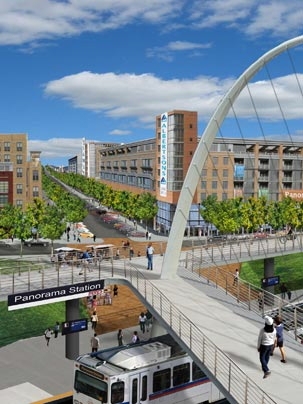A School of Architecture and Planning team's plan to redevelop a 75-acre parcel of land within the city of Denver has won the Urban Land Institute's seventh annual Gerald D. Hines Student Urban Design Competition.
The victory was announced on April 2 following presentations by finalists during a public forum at the University of Denver. The MIT-led student team, which will share the top prize of $50,000, includes MCP candidates Blair Humphreys, Jesse Hunting and Sarah Snider, MArch candidate Duncan McIlvaine, and Eric Komppa of the University of Wisconsin, an MBA and MRED student. The team's advisor was Tunney Lee.
The annual interdisciplinary contest, which is open to graduate students pursuing real estate-related studies at a North American university, challenges teams to craft practical, workable solutions to revitalize or develop an urban site.
For the 2009 competition, students were asked to present schemes for the Denver Design District (DDD), an area just south of downtown that is home to a large commercial design center. The competition charged the teams with redeveloping the entire site and creating a landmark, transformative mixed-use community without losing the current, valuable roster of tenants.
As an added challenge this year, students were asked to consider the massive demographic, climate and financial changes that will likely alter the parcel in coming decades and how their plans would position the DDD in 2050 and beyond.
The SA+P team competed against 91 teams from 42 universities, a field that was then narrowed to the four finalists. The jury selected MIT team's entry over plans submitted by finalists from Columbia, Kansas State and the University of Miami.
The winning entry, "Panorama Station, Proposal for Transit-Oriented Development and Public Space at Alameda Station," incorporates five key objectives: to provide view-oriented public space, to support a 15-minute car-free lifestyle, to create a sense of place, to anticipate future flexible uses for big box spaces and to integrate water-conserving landscapes.
According to Dennis Frenchman, head of SA+P's interdisciplinary City Design and Development Program, the scheme is "stunningly beautiful, sustainable, humane, intellectually rigorous and incredibly innovative -- all in the MIT tradition of city design." Â Â
The Gerald D. Hines Student Urban Design Competition is part of an ongoing effort on the part of the Urban Land Institute to raise interest among young people in creating better communities, improving development patterns and increasing awareness of the need for multidisciplinary solutions to development and design challenges.
The contest is an ideas competition, and there is no guarantee or expectation that any of the submitted schemes will be applied to the site. Rather, it aims to encourage cooperation and teamwork -- necessary talents in the planning, design and development of sustainable communities -- among future land use professionals and allied professions, such as architecture, landscape architecture, urban planning, historic preservation, engineering, real estate development, finance, psychology and law.
A version of this article appeared in MIT Tech Talk on April 8, 2009 (download PDF).






